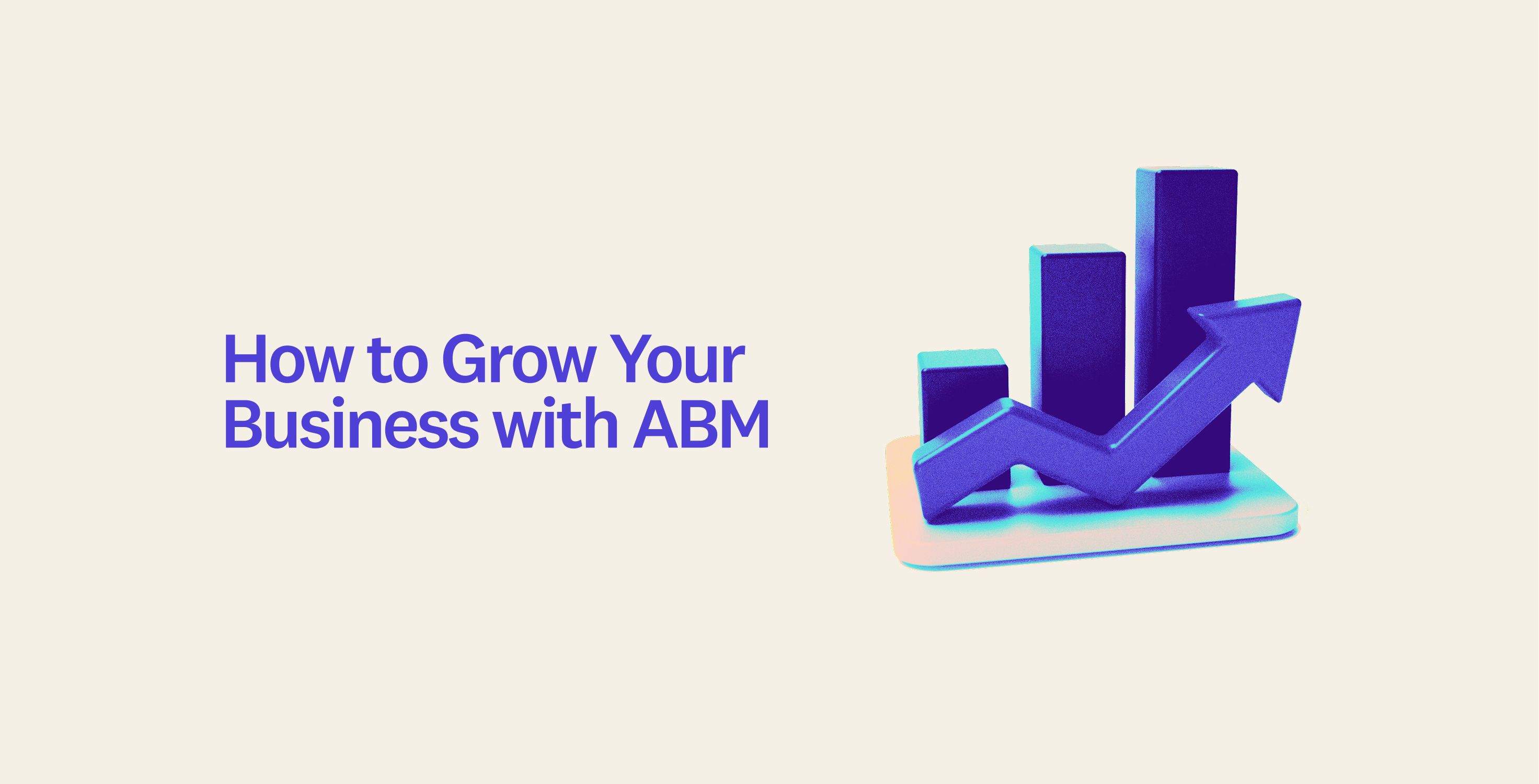
How Account-Based Marketing (ABM) Can Help Grow Your Business
It’s 2025, and the way businesses connect with customers has changed beyond recognition. Audiences are more selective, inboxes are overflowing, and generic campaigns rarely make it past the first scroll. In a world where attention is the new currency, traditional marketing often falls short, reaching many but resonating with few.
Just think about how your own inbox looks today. Ten years ago, a well-designed email blast might have caught your eye. Now, most people swipe away dozens of promotions before finishing their morning coffee. Algorithms filter ads faster than they appear, and decision-makers spend more time researching brands privately than responding to cold outreach. The playing field hasn’t just shifted; it’s become more crowded, competitive, and complex all at once.
That’s where Account-Based Marketing (ABM) comes in. Instead of broadcasting your message to a wide audience and hoping the right people notice, ABM helps you focus your time, budget, and creativity on the accounts that truly matter.
Think of it as precision marketing. ABM unites your sales and marketing teams around shared goals, using personalised campaigns to build genuine relationships with high-value clients. It’s strategic, data-driven, and built for long-term growth.
In this guide, we’ll explore exactly how Account-Based Marketing works, the different types of ABM you can implement, and practical steps for creating a strategy that fits your business. By the end, you’ll have a clear roadmap for turning your best prospects into your most valuable partners.
🔗Also read: Smart ways to access funding as a business
What Is Account-Based Marketing (ABM)?
At its simplest, Account-Based Marketing (ABM) is a focused growth strategy where sales and marketing teams work together to target specific, high-value accounts instead of reaching out to a broad audience. It’s the difference between sending a general message to thousands of people and crafting a personal one for a few that truly matter.
Traditional marketing tends to start with lead generation. You push campaigns to the market, attract whoever responds, and then filter those leads to find the best fits. ABM flips that process. You start by identifying your ideal clients (the companies that are the best match for your product or service) and then tailor every touchpoint around their needs, goals, and decision-making process.
Think of ABM as a bridge between efficiency and empathy. It’s efficient because it focuses your efforts on the most valuable opportunities. It’s empathetic because it treats each target not as a number but as a business with specific goals and people behind them.
In practice, this means your marketing doesn’t just talk at a company; it talks to them. Every piece of content, every ad, and every interaction is designed to address that account’s unique challenges. That level of personalisation is what makes ABM so impactful. Instead of hoping to be noticed, you become impossible to ignore.
ABM also brings sales and marketing into closer alignment than ever before. The two teams share data, insights, and messaging so that every outreach feels connected and purposeful. The result is a smoother buyer journey, stronger relationships, and a better use of resources.
Types of Account-Based Marketing and Which One Fits Your Business
Once you understand what ABM is, the next step is figuring out how to apply it. Not every account or business requires the same approach. ABM comes in three main models: one-to-one, one-to-few, and one-to-many. Each has its own strategy, scale, and ideal use case.
- One-to-One ABM
This is the most personalised form of ABM. You focus on a single high-value account and design campaigns tailored specifically to that company’s needs, challenges, and decision-makers. Every email, meeting, and piece of content is customised, often involving direct collaboration between marketing, sales, and even product teams.
Best for: Large enterprises, high-revenue potential accounts, or companies with complex solutions that require careful nurturing.
- One-to-Few ABM
In this model, you group a small number of similar accounts, usually by industry, company size, or challenges, and create semi-personalised campaigns for each group. This approach allows for some level of personalisation while still scaling your efforts beyond just one account.
Best for: Small to medium-sized businesses or teams looking to balance personalisation and efficiency. It works well when targeting 5 to 20 accounts that share similar characteristics.
- One-to-Many ABM
This approach is closer to traditional marketing but still focuses on targeting specific segments of high-value accounts rather than the general market. You create campaigns that can be slightly personalised by industry, role, or company type, but the volume is higher than the other two models.
Best for: Startups or companies with limited resources that want to reach multiple target accounts efficiently while maintaining some degree of relevance and focus.
Choosing the Right Account-Based Marketing ABM Model for Your Business
- Startups: Often start with one-to-many ABM. Limited resources make highly personalised campaigns difficult, but targeting a well-defined set of potential clients can still yield high ROI.
- SMEs: One-to-few ABM allows for balance. You can scale your efforts while keeping messaging tailored enough to engage prospects meaningfully.
- Enterprises: One-to-one ABM makes the most sense for large, high-value accounts where a deep, personalised strategy can generate significant revenue.
Understanding these ABM types helps you see not just how the strategy works but also which model fits your business goals, resources, and target accounts. Once you know which approach is right, it becomes much easier to plan campaigns, allocate budgets, and align your teams for maximum impact.
🔗ICYMI, here are key tips for you from our first-ever tech, money and business conference: Raenest Exchange.
Why Account-Based Marketing Is Essential for Modern Business Growth
Once you understand what ABM is and the types you can implement, the next question is why it matters. In today’s competitive business environment, not every marketing approach drives meaningful results. ABM stands out because it is strategic, measurable, and focused on high-value opportunities.
- Maximized ROI
One of the biggest advantages of ABM is efficiency. Instead of spreading your resources thin across a broad audience, ABM focuses marketing and sales efforts on accounts that are most likely to convert. Every campaign is designed to move these target accounts closer to a purchase, which means less wasted spend and higher returns. Companies that adopt ABM often report revenue gains significantly higher than those using traditional marketing approaches.
- Stronger Alignment Between Sales and Marketing
ABM requires close collaboration between sales and marketing teams. Shared goals, consistent messaging, and coordinated campaigns ensure that prospects experience a seamless journey from awareness to conversion. This alignment not only improves efficiency but also strengthens relationships with key accounts, building trust and credibility along the way.
- Better Customer Relationships
Because ABM emphasises personalisation, it allows businesses to engage accounts in a more meaningful way. Marketing content, emails, events, and campaigns are all tailored to the specific challenges and goals of each account. This deepens relationships, increases engagement, and ultimately improves retention.
- Shorter Sales Cycles
Targeting the right accounts with relevant messaging speeds up decision-making. When prospects receive content and communications that speak directly to their pain points, they move through the buyer journey faster. This can reduce the time between initial engagement and closed deals, helping your business grow more efficiently.
- Competitive Advantage
In markets where multiple companies compete for the same clients, ABM provides an edge. Personalised, account-specific campaigns make your brand more memorable and relevant. While competitors may still rely on broad marketing tactics, ABM ensures your efforts are precise, impactful, and hard to ignore.
How Account-Based Marketing Works
Now that you understand what ABM is, the types you can adopt, and why it matters, it’s time to explore how it works in practice. While the details can vary by business and model, most successful ABM campaigns share the same core principles, which are:
1. Identifying and Prioritising High-Value Accounts
The foundation of ABM is knowing which accounts matter most. Instead of targeting every potential lead, ABM begins with research to identify high-value prospects and companies that align with your ideal customer profile as well as have the potential for significant impact on revenue. This step often involves analysing industry, company size, purchase history, and strategic fit.
Prioritisation is key. Not all high-value accounts are equal. By ranking accounts based on potential revenue, strategic importance, and likelihood to engage, you can focus your resources on those that will deliver the most meaningful results.
2. Creating Personalised Campaigns
Once target accounts are identified, the next step is personalisation. ABM relies on messaging that is tailored to the specific challenges, goals, and decision-makers of each account. This can include:
- Customised emails or direct outreach
- Targeted content, such as case studies or whitepapers, relevant to the account
- Personalised landing pages or microsites
- Account-specific events or webinars
The goal is to make each interaction feel relevant and valuable. When prospects see that your communications reflect an understanding of their unique needs, engagement rises, and trust is built.
3. Multi-Channel Engagement
ABM is most effective when it reaches decision-makers across multiple channels. Combining email, social media, content marketing, events, and targeted ads ensures that your messaging is consistent and visible wherever your prospects spend time. Multi-channel strategies also increase the chances of engagement by reinforcing your brand and value proposition across different touchpoints.
4. Alignment Between Marketing and Sales
ABM blurs the line between marketing and sales. The two teams work in unison, sharing data, insights, and messaging to ensure every touchpoint is coordinated. This alignment prevents mixed messages, speeds up the sales cycle, and ensures that when a prospect interacts with your company, the experience feels seamless and intentional.
5. Measuring Engagement and Success
Finally, ABM is a data-driven approach. Every campaign should be tracked, measured, and optimised. Key metrics often include engagement rates, deal velocity, account penetration, and overall ROI. By continuously analysing results, teams can adjust messaging, prioritise the most promising accounts, and improve campaign effectiveness over time.
Key Steps to Building a Successful Account-Based Marketing (ABM) Strategy
Understanding ABM’s core principles is one thing. Implementing them effectively is another. Below are the key steps to help your business turn the ABM framework into measurable growth.
- Align Sales and Marketing Teams
ABM only works when sales and marketing are on the same page. Both teams must share:
- Target account lists
- Key messaging and content
- Goals, metrics, and reporting systems
This alignment ensures that every touchpoint, whether a marketing email, a social ad, or a sales call, delivers a consistent message. Collaboration also reduces wasted effort and creates a smoother buyer journey.
- Create Target Account Lists (TAL)
Begin by identifying the companies that have the highest potential value. Consider factors such as industry, company size, budget, and strategic fit. Once the accounts are selected, segment them based on priority so that your team can allocate time and resources effectively.
- Develop Custom Content for Each Account
Content personalisation is at the heart of ABM. Tailor campaigns to each account’s needs, challenges, and goals. Examples include:
- Case studies addressing the account’s industry challenges
- Personalised emails to specific decision-makers
- Account-specific landing pages or microsites
The goal is to make each interaction feel relevant and thoughtful, increasing the likelihood of engagement and conversion.
- Choose the Right ABM Tools and Platforms
Technology can make ABM scalable and efficient. Tools like HubSpot, Demandbase, or Terminus help with:
- Account identification and scoring
- Multi-channel campaign management
- Tracking engagement and ROI
The right platform depends on your business size, goals, and budget, but investing in ABM technology is critical for executing campaigns at scale.
- Launch, Monitor, and Optimise Campaigns
ABM is not a one-time effort. Once campaigns go live, track engagement, deal progression, and revenue outcomes. Use the data to refine your approach, improve personalisation, and focus on accounts showing the highest potential. Continuous optimisation ensures that your ABM strategy remains effective as your business grows.
Final Thoughts
Account-Based Marketing opens a path for businesses to grow with intention and clarity. It encourages teams to focus on meaningful opportunities, making each effort purposeful and connected to overall goals.
Adopting ABM also reshapes the way teams plan, collaborate, and engage, fostering a culture where learning and adaptation guide every decision. Each campaign, interaction, and insight contributes to a continuous process of improvement.
With this approach, growth becomes a steady, deliberate journey. Teams can uncover new opportunities, strengthen relationships, and build momentum in a way that aligns with long-term ambitions.





